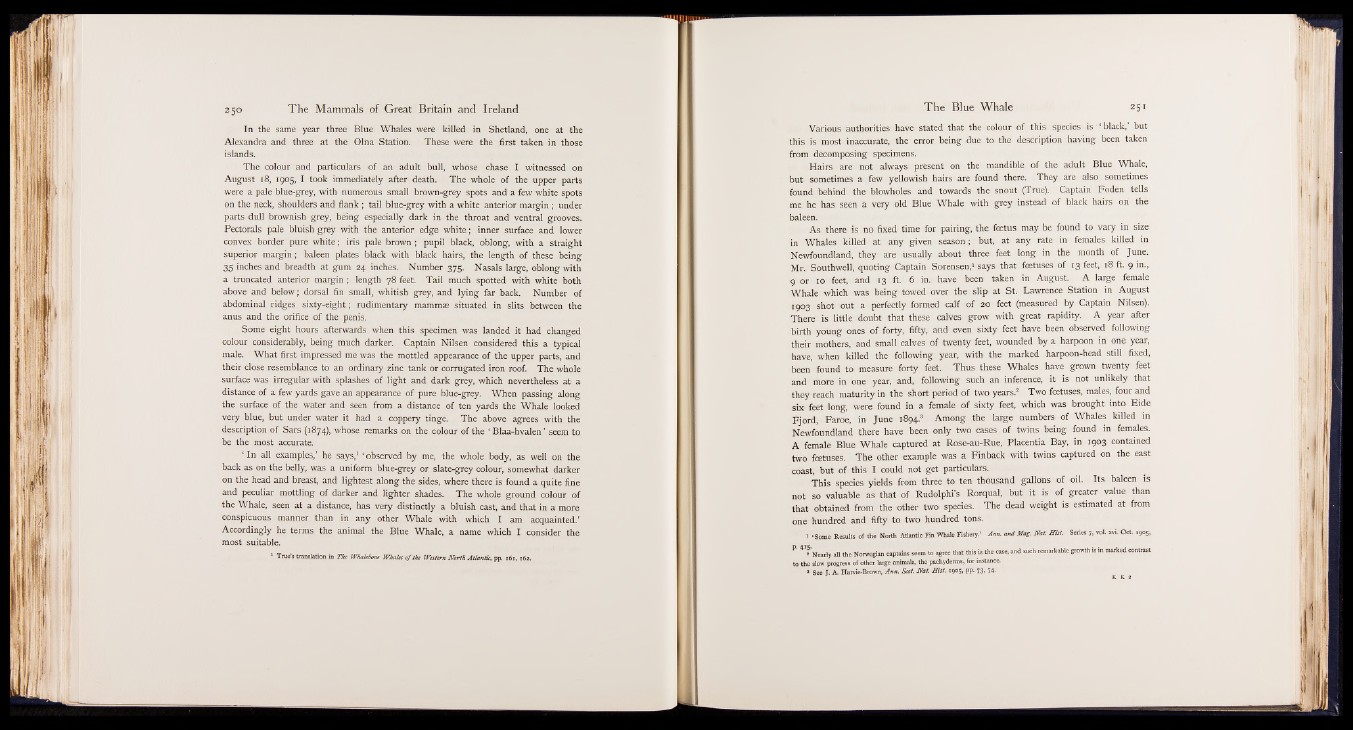
In the same year three Blue. Whales were killed in Shetland, one at the
Alexandra and three at the Olna Station. These were the first taken in those
islands.
The colour and particulars of an adult bull, whose chase I witnessed on
August 18, 1905, I took immediately after death. The whole of the upper parts
were a pale blue-grey, with numerous small brown-grey spots and a few white spots
on the neck, shoulders and flank ; tail blue-grey with a white anterior margin ; under
parts dull brownish grey, being especially dark in the throat and ventral grooves.
Pectorals pale bluish grey with the anterior edge white; inner surface and lower
convex border pure white; iris pale brown ; pupil black, oblong, with a straight
superior margin; baleen plates black with black hairs, the length of these being
35 inches and breadth at gum 24 inches. Number 375. Nasals large, oblong with
a truncated anterior margin ; length 78 feet. Tail much spotted with white both
above and below; dorsal fin small, whitish grey, and lying far back. Number of
abdominal ridges sixty-eight; rudimentary mammae situated in slits between the
anus and the orifice of the penis.
Some eight hours afterwards when this specimen was landed it had changed
colour considerably, being much darker. Captain Nilsen considered this a typical
male. What first impressed me was the mottled appearance of the upper parts, and
their close resemblance to an ordinary zinc tank or corrugated iron roof. The whole
surface was irregular with splashes of light and dark grey, which nevertheless at a
distance of a few yards gave an appearance of pure blue-grey. When passing along
the surface of the water and seen from a distance of ten yards the Whale looked
very blue, but under water it had a coppery tinge. The above agrees with the
description of Sars (1874), whose remarks on the colour of the ‘ Blaa-hvalen ’ seem to
be the most accurate.
‘ In all examples,’ he says,1 ‘ observed by me, the whole body, as well on the
back as on the belly, was a uniform blue-grey or slate-grey colour, somewhat darker
on the head and breast, and lightest along the sides, where there is found a quite fine
and peculiar mottling of darker and lighter shades. The whole ground colour of
the Whale, seen at a distance, has very distinctly a bluish cast, and that in a more
conspicuous manner than in any other Whale with which I am acquainted.’
Accordingly he terms the animal the Blue Whale, a name which I consider the
most suitable.
1 True’s translation in The Whalebone Whales o f the Western North Atlantic, pp. 161, 162.
Various authorities have stated that the colour of this species is ■ ‘ black, but
this is most inaccurate, the error being due to the description having been taken
from decomposing specimens.
Hairs are not always present on the mandible of the adult Blue Whale,
but sometimes a few yellowish hairs are found there. They are also sometimes
found behind the blowholes and towards the snout (True). Captain Foden tells
me he has seen a very old Blue Whale with grey instead of black hairs on the
baleen.
As there is no fixed time for pairing, the foetus may be found to vary in size
in Whales killed at any given season; but, at any rate in females killed in
Newfoundland, they are usually about three feet long in the month of June.
Mr. Southwell, quoting Captain Sorensen,1 says that fcetuses of 13 feet, 18 ft. 9 in.,
9 or 10 feet, and 13 ft. 6 in. have been taken in August. A large female
Whale which was being towed over the slip at St. Lawrence Station in August
1903 shot out a perfectly formed calf of 20 feet (measured by Captain Nilsen).
There is little doubt that these calves grow with great rapidity. A year after
birth young ones of forty, fifty, and even sixty feet have been observed following
their mothers, and small calves of twenty feet, wounded by a harpoon in one year,
have, when killed the following year, with the marked harpoon-head still fixed,
been found to measure forty feet. Thus these Whales have grown twenty feet
and more in one year, and, following such an inference, it is not unlikely that
they reach maturity in the short period of two years.2 Two foetuses, males, four and
six- feet long, were found in a female of sixty feet, which was brought into Eide
Fjord, Faroe, in June 1894.8 Among the large numbers of Whales killed in
Newfoundland there have been only two cases of twins being found in females.
A female Blue Whale captured at Rose-au-Rue, Placentia Bay, in 1903 contained
two foetuses. The other example was a Finback with twins captured on the east
coast, but of this I could not get particulars.
This species yields from three to ten thousand gallons of oil. Its baleen is
not so valuable as that of Rudolphi’s Rorqual, but it is of greater value than
that obtained from the other two species. The dead weight is estimated at from
one hundred and fifty to two hundred tons.
1 ‘ Some Results of the North Atlantic Fin Whale Fishery.’ Ann. and Mag. Nat. H ist. Series 7, vol. xvi. Oct. 1905,
P‘ ^ N e a r ly all the Norwegian captains seem to agree that this is the case, and such remarkable growth is in marked contrast
to the slow progress of other large animals, the pachyderms, for instance.
* See T. A. Harvie-Brown, Ann. Scot. N at. H ist. 1905, pp. 73» 74-
J K K 2